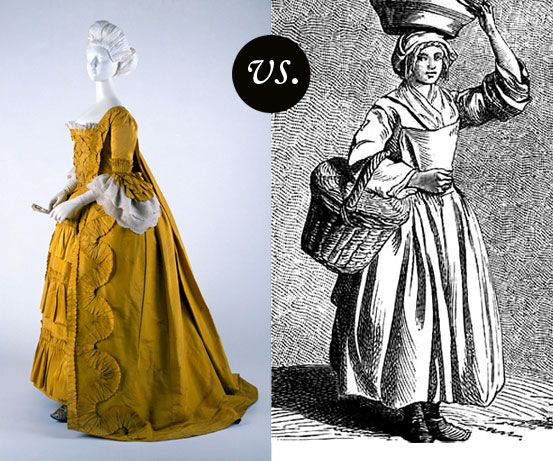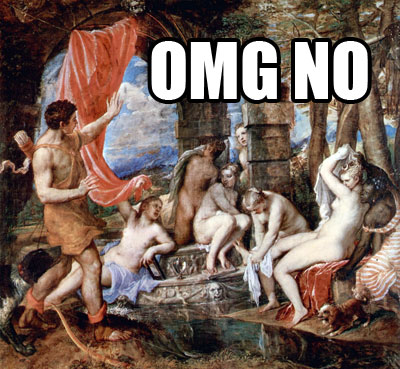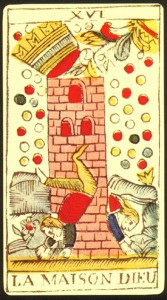Notes for Pages 170-179.
< 160-169 | Notes Index | 180 – 189 >
170. Ariana tends to wear over-long skirts for the era, emphasized here by crouching on the table. The front of most gowns revealed the inner skirts, which tended to stop short of the ground and show those pretty little shoes. On fancy dresses, the ones you tend to see in museum collections, there would be extra material in the back that dragged a bit and created a nice profile. The robe à la française in particular had loads of extra material cascading off the back shoulders. Bu if you were a woman of more limited means, the skirts tended to stay off the ground. You don’t need your own decent wool dress dragging in crap all day long.

171. Barn swallow! These birds are found all over the world, and they’ll gladly turn up anywhere with a high ceiling and an open door policy. Technically their alarm call is rendered as “spee-plink†in English ornithology onomatopeia (I can’t believe I just wrote that phrase), but I couldn’t think of a way to include “plink†without it just seeming goofy.
172. Lent is the liturgical season before Easter. It begins with Ash Wednesday, a day of atonement and reflection on personal mortality which represents the first of the 40 days Christ spent meditating in the desert. It wraps up with Holy Week, the celebration of the ill-fated week he spent in Jerusalem upon returnin. It begins with his triumphant if horribly misinterpreted arrival (Palm Sunday), trucks along to the Last Supper with the disciples (Maundy Thursday), followed by his arrest and his execution (Good Friday) and the nasty waiting period (Holy Saturday) before his resurrection on Easter Sunday.
Lent (literally, “slowâ€) is a quiet time of contemplation, fasting, and preparation. It’s a dark and meditative season in the church year. Having a bunch of horny birds zipping around and twittering at top volume – not conducive.
173. I can’t claim credit for the frontispiece – it’s once again from the 1563 Johann Spreng edition of Ovid’s Metamorphoses, with pictures by Virgil Solis. God bless you all for thinking me capable of it, though.

174. Paul’s writing are full of conversions and revelations, starting with his own (the famous story of Saul, a Jewish tent-maker content to collaborate with the Roman occupation, being struck with enlightenment while on the road to Damascus, and thereafter becoming the Jesus-follower Paul). He later branches out to the exciting conversion stories of many misfit individuals encountered on his evangelistic travels.
Hot ladies turning men into deer, sexy nymphs transforming into trees to avoid being jumped, etc, would not really be part of his program.
…and here is the card catalog! As mentioned before, these didn’t really exist yet – the first recorded mention of one is during the French Revolution when the state was selling off its assets and needed a quick way to flip through (and then flip…) a whole library of sellable volumes. Ariana has her own picky system here that is more reverse-lookup (“where in general is this exact book in this exact physical library?”) than Dewey Decimal/LoC (“where can I find all the books in this subject in every library and know what order they will be shelved in no matter which volumes the individual collection contains?”)
Somebody asked why her handwriting isn’t proper German handwriting, but is in fact a nice example of English Roundhand. I could give you a cute story answer and say that her writing tutor was an English scholar fleeing blah blah blah. The real answer is that I wanted you to be able to read what she’d written, clean examples of casual German script from the time are hard to hunt down, and I think this typeface is pretty. It’s actually derived from the writing of Timothy Matlack, whose work you can see in the body of the original Declaration of Independence. This version is called P22 Declaration, from the P22 Type Foundry.
175. Actually keeping track of books past the simple fact of their acquisition was a new idea. Remember that we’re coming out of a time when books where just chained to the shelf or to a podium if they had any value.
“From a state of nature to a free republic†– Luther has been reading Rousseau in his spare time. According to Rousseau, in the “state of natureâ€, it’s each man for himself, completely free but also subject to great personal risk; in a “republicâ€, everybody concedes some of their personal freedom in exchange for the safety and convenience of the group. This gave rise, for better or worse, to agriculture, specialized professions, organized religion, etc.
I like the idea of advances in the modern library somehow echoing the advances of civilization; everybody  accounted for from birth to death, particular sections self-distinguished from others, etc.
accounted for from birth to death, particular sections self-distinguished from others, etc.
But that’s because I’m a nerd.
176. The Tower (or in French, the God-House) is one of the Major Arcana – super important cards – in the traditional Tarot deck. To the modern eye it depicts the biblical Tower of Babel, a tower built so ambitiously high that it incurred the wrath of God and was destroyed. There’s plenty of other precedent for towers being destroyed in Christian iconography, though, so the tower has been variously identified over time.
In most versions of this card, a holy fire is blasting off an ostentatious crowned roof, and a few hapless humans are toppling to the earth below. In the Marseille deck, colorful meteorites fall from the sky as well. The card is typically interpreted as the fall that comes after pride, the general destruction of human hopes and ambitions. It’s one of the grimmest cards in the deck (much grimmer than Death), a sign that you’d better check your stocks and contact your loved ones.
Here’s a link to a great discussion of the iconography of this card on the Tarot history forum.
I goofed up the number. It should be 16 in the deck, not 14. I’ll fix it eventually.